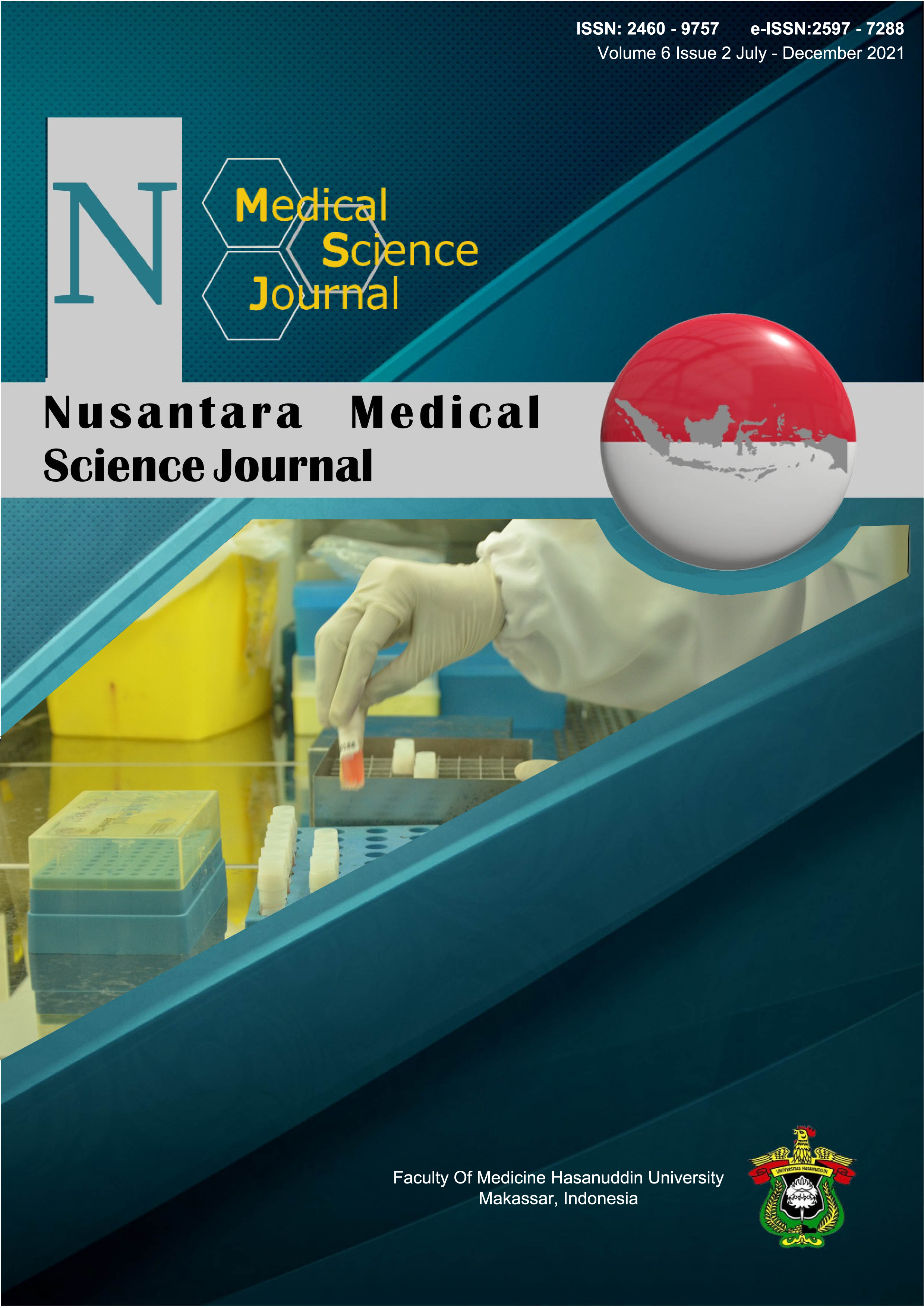Antibiotic Susceptibility Pattern in Clinical Isolates of Pseudomonas aeruginosa
DOI:
https://doi.org/10.20956/nmsj.v6i2.14172Abstract
Introduction: Pseudomonas aeruginosa is an opportunistic pathogen and causes of nosocomial infections in hospitals. Due to high antibiotic resistance and the ability to develop new resistance during antibiotic treatment, Pseudomonas aeruginosa infection is difficult to eradicate because the physical treatment becomes difficult and ineffective. This study was conducted to evaluate the antibiotic sensitivity pattern of Pseudomonas aeruginosa strains at two different hospital in Makassar. Methods: This study is a cross-sectional study from March to May 2021. The research samples were taken from the results of culture and antibiotic sensitivity tests conducted at two different hospital, Hasanuddin University Hospital and Dr. Wahidin Sudirohusodo Hospital for the period January 1 to September 30, 2019. A total of 84 samples were cultured and tested for antibiotic sensitivity of Pseudomonas aeruginosa. Results: Antibiotic sensitivity of Pseudomonas aeruginosa was best with aminoglycoside antibiotics, gentamicin (100%) at Hasanuddin University Hospital and amikacin (95.8%) at Dr. Wahidin Sudirohusodo Hospital. At Hasanuddin University Hospital followed by antibiotics amikacin (92.3%) and meropenem (84.6%). At Dr. Wahidin Sudirohusodo Hospital, Pseudomonas aeruginosa also showed good sensitivity to gentamicin (91.5%) and meropenem (77.5%). The sensitivity of Pseudomonas aeruginosa was lowest to piperacillin/tazobactam. Conclusions: This study shows that the level of effectiveness of the antibiotics meropenem, amikacin and gentamicin is high enough and it can be used as a treatment option in Pseudomonas aeruginosa infection. This study can help as a reference to prevent mortality and morbidity associated with Pseudomonas aeruginosa infection.
References
Lister PD, Wolter DJ, Hanson ND. Antibacterial-resistant Pseudomonas aeruginosa: clinical impact and complex regulation of chromosomally encoded resistance mechanisms. Clin Microbiol Rev. 2009; 22(4): 582–610.
Azimi S, Kafil HS, Baghi HB, Shokrian S, Najaf K, et al. Presence of exoY, exoS, exoU, and exoT genes, antibiotic resistance and biofilm production among Pseudomonas aeruginosa isolates in Northwest Iran. GMS Hygiene and Infection Control. 2016; 11:2-6
Wu DC, Chan WW, Metelitsa AI, Fiorillo L, Lin AN. Pseudomonas skin infection. Am J Clin Dermatol. 2011;12(3):157–169.
Bavasheh N, Karmostaji A. Antibiotic Resistance Pattern and Evaluation of blaOXA-10, blaPER-1, blaVEB, blaSHV Genes in Clinical Isolates of Pseudomonas aeruginosa Isolated from Hospital in South of Iran in 2014-2015. Infect Epidemiol Med. 2017; 3 (1): 1-5.
Ahmed OB, Asghar AH. Antibiotic susceptibility pattern of Pseudomonas aeruginosa expressing blaGES and blaPER genes in two different hospitals. African Journal of Biotechnology. 2017; 16(21): 1197-1202
Lin SP, Liu MF, Lin CF, Shi ZY. Phenotypic detection and polymerase chain reaction screening of extended-spectrum b-lactamases produced by Pseudomonas aeruginosa isolates. Journal of Microbiology, Immunology, and Infection. 2012; 45: 200-207
Lim C, Takahashi E, Hongsuwan M, Wuthiekanun V, Thamlikitkul V, et al. Epidemiology and burden of multidrug-resistant bacterial infection in a developing country. eLife Research Article. 2016; 5: 1-18.
Kanj SS, Kanafani ZA. Current concepts in antimicrobial therapy against resistant gram-negative organisms: extended-spectrum beta-lactamase-producing Enterobacteriaceae, carbapenem-resistant Enterobacteriaceae, and multidrug-resistant Pseudomonas aeruginosa. Mayo Clin Proc. 2011; 86(3): 250–9.
Tarafdar F, Jafari B, Azimi T. Evaluating the antimicrobial resistance patterns and molecular frequency of blaoxa-48 and blaGES-2 genes in Pseudomonas aeruginosa and Acinetobacter baumannii strains isolated from burn wound infection in Tehran, Iran. New Microbe and New Infect. 2020; 37: 1-7.
Dejsirilert S, Suankratay C, Trakulsomboon S, Thongmali O, Sawanpanyalert P, Aswapokee N, dkk. National Antimicrobial Resistance Surveillance, Thailand (NARST) data among clinical isolates of Pseudomonas aeruginosa in Thailand from 2000 to 2005. J Med Assoc Thai. 2009; 92(4): 68–75.
Anggraini D, Yulindra UG, Savira M, Djojosugito FA, Hidayat N. Prevalensi dan Pola Sensitivitas Antimikrob Multidrug Resistant Pseudomonas aeruginosa di RSUD Arifin Achmad. Majalah Kedokteran Bandung (MKB). 2018; 50(1): 6–12.
Amirkamali S, Naserpour-Farivar T, Azarhoosh K, Peymani A. Distribution of the bla OXA, bla VEB-1, and bla GES-1 genes and resistance patterns of ESBL-producing Pseudomonas aeruginosa isolated from hospitals in Tehran and Qazvin, Iran. Revista da Sociedade Brasileira de Medicina Tropical. 2017; 50(3): 315-320.
Strateva T, Ouzounova-Raykova V, Markova B, Todorova A., Marteva-Proevska Y, Mitov I. Problematic clinical isolates of Pseudomonas aeruginosa from the university hospitals in Sofia, Bulgaria: current status of antimicrobial resistance and prevailing resistance mechanisms. Journal of medical microbiology. .2007; 56(7): 956-963.
Farshadzadeh Z, Khosravi AD, Alavi SM, Parhizgari N, Hoveizavi H. Spread of extended-spectrum β-lactamase genes of bla OXA-10, bla PER-1 and bla CTX-M in Pseudomonas aeruginosa strains isolated from burn patients. Burns. 2014; 40(8): 1575-1580.
Agbo MC, Ezeonu IM, Odo MN, Ononugbo CM, Onodagu BO, et al. Phenotypic and molecular characterization of extended-spectrum β-lactamase producing Pseudomonas aeruginosa in Nigeria. African Journal of Biotechnology. 2019; 18(32): 1083-1090.
Alikhani MY, Tabar ZK, Mihani F, Kalantar E, Karami P, et al. Antimicrobial Resistance Patterns and Prevalence of blaPER-1 and blaVEB-1Genes Among ESBL-producing Pseudomonas aeruginosa Isolates in West of Iran. Jundishapur J Microbiol. 2014; 7(1): 1-5.
Mehta A, Prabhu T. Detection and characterization of metallo-β-lactamases producing Pseudomonas aeruginosa clinical isolates at a tertiary care hospital of Bhopal, India. International Journal of Research in Medical Sciences. 2016; 4(9): 4084-4088.
Downloads
Published
How to Cite
Issue
Section
License
Copyright (c) 2021 Nusantara Medical Science Journal

This work is licensed under a Creative Commons Attribution 4.0 International License.









